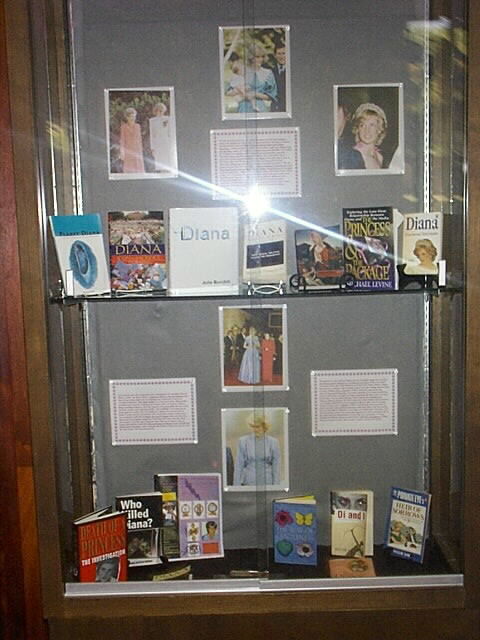Princess Diana Exhibit, Case Three

Placard, Shelf One

Placard, Shelf One
The last two years have also
seen the publication of books that attempt to analyze the significance
of her life and death and assess her place in history. Among the best works
are Planet Diana: Cultural Studies and Global Mourning (1997),
a collection of essays from an Australian conference, Diana: Icon and
Sacrifice (1998), written by a religious correspondent from the BBC
who studies her in historical, religious, and anthropological perspectives,
and Julie Burchill's Diana (1998), the first biography to analyze
the events of her life as opposed to merely chronicling them.
A feminist interpretation
of how Diana's marital problems and her public persona influenced the House
of Windsor is told in Diana, Princess of Wales: How Sexual Politics
Shook the Monarchy (1998).The cover of After Diana (1998)
irreverently depicts her as the Virgin Mary and the quality of its essays
are uneven, but it is an interesting glimpse into current treatment of
her by British academics. The one good study from the US is The Princess
and the Package: Exploring the Love-Hate Relationship Between Diana
and the Media (1998). Diana: Fractured Fairytales (1998) is
one of many books which examines the meaning of her death in the context
of the crisis in contemporary spirituality and diminished church attendance.
And the anniversary of her death continues to produce additional titles:
forthcoming books this year (1999) include two studies on the psychological
significance of the public mourning, one science fiction novel, and major
biographies from Sally Bedell Smith, biographer of Pamela Harriman, and
Anne Edwards, who has written books about Queen Mary, Vivien Leigh, and
Margaret Mitchell.
Images Below: Left and Right Sides of Shelf One


Placard, Left Side of Shelf Two
Several books have been inspired
by the circumstances surrounding Princess Diana’s death. The best of these
is Death of a Princess: the Investigation (1998), but since it was
written before the investigation was completed, it cannot be considered
definitive. Who Killed Diana? (1998) is a conspiracy book, with
possible contenders for assassins ranging from enemies of the Al-Fayeds
to MI6 to Hollywood film producers, and with scenarios for perpetrating
the deed which would be worthy of an espionage thriller. (Its credibility
is not helped by its frank appeal to readers who are looking for “figures
on a grassy knoll in Dallas, thumps heard in Brentwood, and soft metallic
artifacts at Roswell”.) The revelations contained in Diana: the Last24
Hours (1999) claim to be based on transcripts from bugging equipment
in the Imperial Suite at the Ritz Hotel. And thanks to internet super bookstores
like Amazon, it is much easier to locate self published books like Diana
the Queen of Hearts & the CIA/MI6 the Princedom of Darkness
(1997), which contends that Princess Diana was murdered by the same groups
that assassinated JFK.
Image Below: Left Side of Shelf Two

Placard, Right Side of Shelf Two
Throughout her life, Princess
Diana was an irresistible subject for novelists. The Prince and the
Princess: a Very Special Love Story (1983) was written very much in
the style of the Barbara Cartland novels which Princess Diana had loved
as a teenager and included a happy-ever-after ending with the birth of
Prince William.
Heir of Sorrows (1988), which first appeared in
the satirical magazine Private Eye, was a more jaundiced view that,
considering what we know now, was quite accurate in depicting the state
of the marriage at that time. A novel called Princess (1991) depicted
the kidnapping of Princess Diana by Basque terrorists while on a visit
to Spain, which caused it to be heavily criticized for fear it would give
ideas to other terrorist groups.
The best of the novels before
1999 is
Di and I (1994), a wonderfully humorous book in which she
falls in love with an American writer and elopes with him and the boys
to a new life in California as co-owner of a McDonald’s franchise. And
since her death, at least two novels have appeared in which she did not
die in the tunnel and was spirited away to a new life. (So watch those
7-11s for sightings of Princess Diana as well as Elvis and JFK Jr.) The
Way of Gentleness (1998) sends her to Greece where she becomes a noted
counselor and healer.
Image Below: Right Side of Shelf Two

Go back to Case
Two
Return to Exhibit
Introduction
Return home to Princess
Diana Shopping Arcade